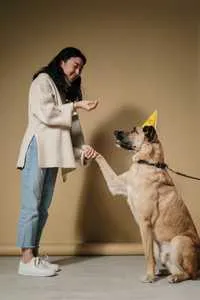Bringing a dog into your home is an incredibly rewarding experience, and beyond providing love and basic care, teaching them various Dog Tricks To Teach Dog is a fantastic way to deepen your bond. We know from personal experience, with our anxious dog Scott, that trick training offers more than just entertainment; it provides crucial mental stimulation that helps calm the nervous system and fosters a stronger connection between you and your pet. It’s often said, “a tired dog is a good dog,” but it’s even more accurate to say “a mentally stimulated dog is a well-behaved dog.” Engaging your dog’s mind with new challenges can significantly reduce common unwanted behaviors like excessive barking, digging, or counter-surfing, transforming potential frustrations into joyful learning moments. In fact, understanding the comprehensive needs of your canine, including mental enrichment, can be as vital as budgeting for their overall well-being. For a deeper dive into the financial commitments, consider exploring the average annual cost of owning a dog.
Beyond the behavioral benefits, teaching your dog new tricks is simply a lot of fun for both of you. It builds confidence in your dog, reinforces positive communication, and creates memorable moments. So, grab some tasty treats, prepare your clicker (or a clear “yes!”), and let’s explore some engaging dog tricks to teach dog that will impress your friends and enrich your dog’s life.
1. Shake Hands: A Classic Canine Greeting
One of the most straightforward and charming dog tricks to teach dog is the “shake hands” command. It’s a fundamental trick that can build a great foundation for more complex behaviors.
How to teach:
- Initial Lure: Start by having your dog sit in front of you. Hold out your hand, palm open, at their chest level. Many dogs will naturally offer a paw to investigate or attempt to get a treat if they see one.
- Mark and Reward: The instant your dog’s paw touches your hand, mark the behavior with a clicker or a clear verbal cue like “yes!” immediately followed by a high-value treat.
- Repeat and Fade Lure: Repeat this process several times. If your dog isn’t pawing, you can gently hold a treat in your hand to encourage them to paw at it, but be careful to fade this lure quickly. The goal is for them to paw your empty hand.
- Add the Verbal Cue: Once your dog consistently paws at your outstretched hand, introduce your chosen verbal cue, such as “shake” or “how do you do?” Say the cue just before you offer your hand.
- Practice: Practice in short, fun sessions until your dog offers their paw reliably when you give the command.
Troubleshooting: If your dog is reluctant to paw, gently tap their paw or lift it slightly while saying “shake,” then immediately reward. Ensure the treat isn’t the focus of their pawing; you want them to touch your hand, not try to get food from it.
 A medium-sized dog, possibly a Golden Retriever mix, shaking a person's hand with its paw, demonstrating a classic dog trick.
A medium-sized dog, possibly a Golden Retriever mix, shaking a person's hand with its paw, demonstrating a classic dog trick.
2. Tell Me a Secret: A Unique and Adorable Interaction
This delightful trick is guaranteed to bring smiles and is surprisingly easy to teach, making it one of the most unique dog tricks to teach dog.
How to teach:
- The Gesture: Hold a treat between your thumb and forefinger, bringing your hand up to your ear as if you’re cupping it to hear a secret. This gesture acts as a natural lure.
- Encourage Closeness: When your dog leans in or moves their nose towards your ear to investigate the treat, mark (click or “yes!”) and immediately give them the treat.
- Repetition: Repeat this several times. Your dog will quickly associate the gesture with getting a treat and will start moving towards your ear.
- Fade the Lure and Add Cue: Once your dog reliably comes close to your ear when you make the gesture, you can start to fade the visible treat. Introduce your verbal cue, such as “tell me a secret,” just before you bring your hand to your ear.
- Refine: Continue practicing until your dog responds to the verbal cue and gesture by gently nudging their nose towards your ear, creating the illusion of whispering a secret.
3. Play Dead: A Dramatically Fun Dog Trick
“Play dead” is a slightly more advanced but incredibly impressive trick. It requires a bit more coordination from your dog, but with patience, it’s definitely one of the rewarding dog tricks to teach dog.
How to teach:
- Start with “Down”: Begin by asking your dog to lie down.
- Lure to Roll: Hold a high-value treat in front of their nose and slowly move it in an arc towards their shoulder, then behind their head and down towards the ground. As your dog follows the treat, they should naturally roll onto their side.
- Mark and Reward: The moment your dog rolls onto their side, mark the behavior and reward them generously.
- Repeat and Refine: Practice this motion until your dog consistently rolls onto their side.
- Add the Cue: Once they are proficient, introduce your chosen verbal cue, such as “play dead” or “bang!” just before you initiate the lure.
- Increase Difficulty: After your dog understands the verbal cue while lying down, you can challenge them by having them start from a standing position, or even pretend to “shoot” them with your hand and then give the cue.
Important Note: Some dogs, particularly older ones or those with joint issues, might find rolling onto their hip uncomfortable. Always observe your dog for signs of discomfort. If they don’t seem to be enjoying it or show any pain, stop training this trick immediately. No trick is worth your dog’s pain or distress.
4. High Five: A Paw-some Celebration
Building on the “shake hands” trick, the high five is a spirited way to celebrate accomplishments and is one of the most enthusiastic dog tricks to teach dog.
How to teach:
- Build on “Shake”: Ensure your dog has mastered the “shake hands” trick (see trick #1).
- Elevate Your Hand: Once your dog is proficient at shaking, hold your hand higher than usual, in the classic high-five position.
- Encourage the Lift: Your dog, expecting to shake, should lift their paw and might naturally reach higher to touch your elevated hand. The instant their paw touches your hand, mark and reward.
- Repeat and Cue: Repeat this process, gradually raising your hand more if needed, until your dog consistently gives you a high five. Then, introduce your verbal cue, such as “high five!” just before you present your hand.
- Practice: With regular, positive reinforcement, your dog will be giving enthusiastic high fives in no time.
 A brown dog with an open mouth, possibly a Labrador, high-fiving a woman's hand, showing a joyful interaction.
A brown dog with an open mouth, possibly a Labrador, high-fiving a woman's hand, showing a joyful interaction.
5. Play Ball: The Impressive Soccer Star
This uncommon trick will truly make your dog stand out, making onlookers believe you have the next “Air Bud” on your hands. Teaching your dog to “play ball” (by nudging it with their nose or paw) requires a training concept called shaping, which is incredibly useful for teaching complex dog tricks to teach dog.
Understanding Shaping: Shaping involves rewarding your dog for small, successive approximations of a desired behavior. You break down a complex action into tiny, achievable steps, rewarding each step closer to the final goal.
How to teach:
- Choose Your Ball: Select any ball that’s safe for your dog.
- Step 1: Look at the Ball: Place the ball on the floor near your dog. The moment your dog looks at the ball, mark (“yes!” or click) and immediately give a treat. Repeat a few times.
- Step 2: Move Towards the Ball: Wait until your dog takes a step or moves their body towards the ball. Mark and reinforce. Repeat.
- Step 3: Touch the Ball: Now, wait until your dog touches the ball (with their nose or paw, depending on what you prefer as the end behavior). Mark and reinforce. Repeat.
- Step 4: Interact with Force: Finally, wait to mark and reinforce until your dog touches the ball with enough force that it moves. This signifies they are actively “playing” with it.
- Add the Cue: Once your dog is consistently moving the ball, introduce your verbal cue “play ball” just before they go to hit it.
Shaping teaches your dog to think and offers incredible mental stimulation, transforming potentially destructive behaviors into positive interactions. For instance, if your dog tends to chew on inappropriate items, teaching them to interact positively with toys can redirect that energy. You might find insightful connections regarding suitable chew toys and dog behavior by exploring resources like i could chew on this.
Conclusion
Teaching your dog these fun and engaging dog tricks to teach dog not only ensures they’ll be the star of the show during family gatherings but also provides them with vital mental stimulation they need to thrive. It’s a wonderful way to foster a stronger bond, improve communication, and channel their energy into positive, constructive activities. Remember, patience, consistency, and positive reinforcement are key to successful dog training. So, gather your treats, practice your marking signal, and embark on this rewarding journey of trick training with your beloved canine companion. You’ll both have a blast!
